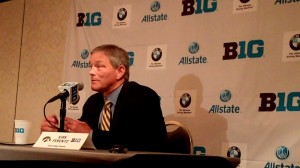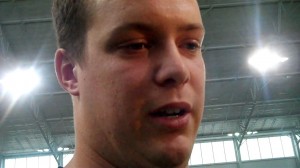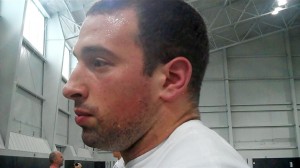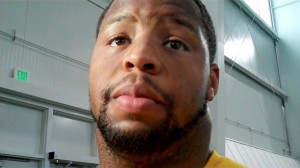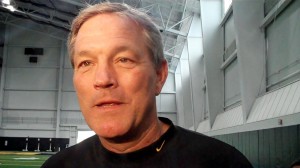2013 Big Ten Media Days — Day Two observations
By Brendan Stiles
HawkeyeDrive.com
CHICAGO, Ill. — The second and final day of Big Ten Football Media Days concluded at the Hilton Chicago Thursday morning. The format for the second day is much different in that there are no press conferences, podiums, or anything considered “made-for-TV.”
The second day’s format was similar to what it has always been — players and coaches sitting at individual roundtables and reporters walking up to them asking questions for two hours straight. Because I changed my coverage format a little during Day One with the list of takeaways I made hearing each coach, I decided what I’d write for Day Two would be what I’ve typically written on Day One — a list of observations about the conference as a whole and providing a glimpse into what I foresee with the Big Ten in 2013.
1. Ohio State is the clear front-runner
And this isn’t close, either. This is a team that overcame sanctions and went 12-0 last season — Urban Meyer’s first — despite not being allowed to play in the Big Ten Championship Game or a bowl.
Regardless of the legal issues that surfaced at Ohio State earlier this week, the spotlight this week was always going to be on Meyer and it was always going to be on his junior quarterback, Braxton Miller. Right now, Meyer is being viewed as the league’s top coach and Miller the league’s top signal-caller.
Aspirations are high in Columbus and rightfully so. This is a team that’s going to viewed nationally as a team that can play in the final BCS National Championship Game before next year’s college playoff. The two potential road blocks I see are both road games — Oct. 5 at Northwestern and Nov. 30 at Michigan. The latter is obvious for anyone who has ever watched Big Ten football. The former is a game that features a Northwestern team on the rise after winning its first bowl since the 1949 Rose Bowl. It’s also the school’s Homecoming game and it’s already been scheduled for prime time. Looking at it from an Iowa perspective, this Ohio State/Northwestern game has some parallels to the Hawkeyes’ contest against then-No. 1 Ohio State back in 2006 at Kinnick Stadium.
Now I don’t necessarily think Miller ends up winning the Heisman Trophy (although I can definitely see him being a finalist). But he’s the Big Ten’s best quarterback right now and I think he’ll be enough of a difference-maker again for the Buckeyes, which is why I would be surprised if anyone else wins this conference in 2013.
2. No coach really on the hot seat
Every year, there’s talk about which coach is on the proverbial hot seat, and in all honesty, I don’t think any of the 12 coaches currently in the Big Ten are.
Some might suggest Bo Pelini is at Nebraska, but the schedule is tailor-made for the Cornhuskers to be in position for a return to the Big Ten Championship Game. Others might say Tim Beckman and Kirk Ferentz because of how their seasons went last year at Illinois and Iowa, respectively. But I think both their ADs are committed to sticking by them. Most of you who visit or subscribe to this site already know how Ferentz is viewed by his players, and from talking to Illinois defensive tackle Tim Kynard on Thursday, I got the sense Beckman is someone who his players respect a ton.
In a league where the last three years have brought in eight new head coaches (nine if you want to count Pelini when Nebraska joined, even though he was already well in place as its head coach beforehand), I have a feeling the offseason will be rather quiet on the coaching front and the only two newbies you’ll hear about are the guys currently in place at future members Maryland and Rutgers — Randy Edsall (Maryland) and Kyle Flood (Rutgers).
3. Indiana will go bowling in 2013
I said it two years ago after Indiana first hired Kevin Wilson that the move eventually pay off for the Hoosiers and I think this is the season it happens.
Indiana has eight games at Memorial Stadium this season. Eight of them, and all eight games are winnable. Of course, part of this hinges on the return of Tre’ Roberson at quarterback after he tore his ACL in the Hoosiers’ second game of last season against Massachusetts. If he’s back healthy, and Wilson said on Wednesday he should be, he’s clearly Indiana’s best option at quarterback and the pieces are in place. Wilson has the guys he wants in his system. This is a team that hung with the likes of Michigan State and Ohio State last season and beat on some of the worse teams in the league like Illinois and Iowa.
Assuming the Hoosiers can handle their business at home (because the four road games they have are absolutely brutal), there’s no reason to think Indiana isn’t a bowl team this season. Enough is in place for the Hoosiers to get at least that far.
4. November will decide the Legends Division
Right now, the consensus would probably be that any one of four teams could win the Legends Division in 2013 — Michigan, Michigan State, Nebraska and Northwestern.
And as it turns out, all six of the games involving two of these four teams take place during the final month of the regular season. Nov. 2, the Wolverines and Spartans meet in East Lansing, while the Wildcats and Cornhuskers play in Lincoln. Nov. 9, Nebraska travels to Michigan and looking at both teams’ schedules, it’s not out of the realm of possibility that both teams could enter that game undefeated (assuming they both win the week before). Nov. 16, Michigan State travels to Nebraska and Michigan plays at Northwestern and then on Nov. 23, the Spartans get their turn at Ryan Field against the Wildcats.
Simply put, whichever team of these four plays the best during November is going to be the one playing in Indianapolis against (most likely) Ohio State on Dec. 7.
5. Big Ten will be better, but not much better
From an overall perspective, 2012 was a year to forget for the Big Ten. It had two teams that went a combined 20-4 on postseason bans, a team that finished third in its division won the Big Ten Championship Game and its head coach left to take another job three days later, and the league had only one team in a BCS bowl for the first time since 2004.
The Big Ten won’t be much better in 2013, but it also isn’t going to be as bad as it was last year. I do think there will be two BCS bowl teams again this season, and if Ohio State lives up to the hype it’ll have, there will probably be two teams in Pasadena over a span of six days.
On a national scale, this conference obviously isn’t better than the SEC at football, but no one is. After the SEC though, what exactly is there? The Big 12 is going to be more wide open than ever before and both the ACC and Pac-12 have situations where its two best teams play in the same division.
The Big Ten is going to end up with a better title game than what transpired last December and I would venture to guess that it gets about 8-9 teams into bowl games as opposed to just seven in 2012. The big question then will obviously be how the conference fares in said bowl games, but the perception around it doesn’t appear as bad as it was, which has to be encouraging for the Big Ten going forward.
6. How the Big Ten’s Media Days could be going forward
When Maryland and Rutgers officially join in 2014, the question I have is what eventually happens with the format of this event going forward.
On one hand, there are going to be 14 teams. From a reporter’s perspective, if the format stays the same, that’s 14 different head coaches plus Big Ten commissioner Jim Delany conducting press conferences all in one day. Believe it or not, burnout can happen and that probably had somewhat to do with why so few questions ended up getting asked of Ferentz during his press conference, which was the 12th and final coaches’ presser. A lot is being said, therefore a lot is going to be written and time is obviously of the essence for those on deadline.
On the other hand however, there’s the Big Ten Kickoff Luncheon that takes place the second day, which is an event for fans of every school that the coaches and players all take part in. As long as this is in place, the format probably won’t change.
That leads to me asking this — Is the luncheon that necessary? Because if the answer is no, then the Big Ten could do what the SEC does (and did last week) where they make this three days instead of two, but divide it up so certain days feature certain schools and whatever day a school is listed is the only day its coaches and players are available. With two TV networks in place — ESPN and BTN — this is an opportunity I’m sure will at least garner discussion at Big Ten headquarters.
7. What would be my preseason ballot
As I do every year when I write this, I put together what would’ve been my preseason Big Ten ballot had the conference continued providing the media with those as it once did once upon a time. Here’s what my list would be for division winners and preseason picks for Big Ten Offensive and Defensive Players of the Year:
- LEGENDS DIVISION — Nebraska
- LEADERS DIVISION — Ohio State
- OFFENSIVE PLAYER — Braxton Miller, QB, Ohio State
- DEFENSIVE PLAYER — Ra’Shede Hageman, DL, Minnesota
